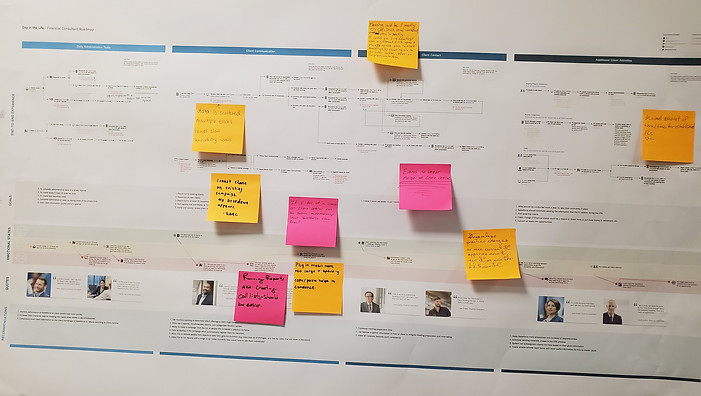Financial Advisor Salesforce Journey

Challenge
I worked for a company who had Financial Advisors. They had recently invested in Salesforce and were rolling it out to their Financial Advisors across the company. The problem was that they didn't really understand the workflow of those users, nor did they feel they could access those users in the field. I needed to find a way to work with the Financial Advisors and create a user journey map that would define both the workflow and help to prioritize the development priorities of the Salesforce development team. In addition, they wanted to determine whether they should invest in a particular solution.
Method
Initially I worked with Financial Advisors who were in the headquarter offices. As I got more connected within the company, I was able to get permission to reach out the Financial Advisors throughout the company. I conducted a contextual inquiry project with the Financial Advisors in the headquarters and then out in the field in offices in the larger Denver metro area. I sat with advisors as they conducted their work as well as interviewing them on details as they arose.
From this, I was able to assemble a journey map of the daily activities of the advisors (shown in the image above). I then produced versions of the maps which I brought to various branch locations. I had the advisors I had worked with and others comment and add to the journey map. I used this additional data to refine the flow until I had a final version for the team.
Using this, the team was able to develop a new solution concept to see if it would aid the advisors in their workflow. Once the concept was working, I ran usability testing, focus groups and Technology Acceptance Modal (TAM) surveys to see if the concept solution would be useful to the advisors in their work.
Impact
The solution concept was not well-received by the advisors. I was able to show that they did not feel that it added significant value to their workflow. We considered whether to revise the project or abandon it. The decision was not to go forward, which saved the company hundreds of thousands of dollars in development for something that would not have been adopted in the field.
The journey map was described by the head of the software development group as "invaluable to their 2020 roadmap." They continually referred to this journey map as providing unique insights into the work that their advisors were doing, which they did not have prior to my efforts.
Research Highlights:
-
Contextual Inquiry
-
Journey Mapping
-
Survey development
-
Technology Acceptance Model
-
Guerilla recruiting
-
Data analysis